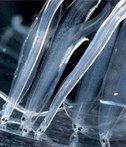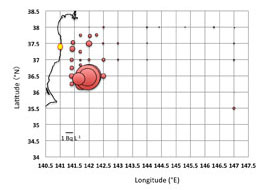2012
-

A Low Trophic Position of Japanese Eel Larvae Indicates Feeding on Marine Snow
What eel larvae feed on in the surface layer of the ocean has remained mysterious. Gut contents and bulk nitrogen stable isotope studies suggested that these larvae, called leptocephali, feed at a low level in the oceanic food web, whereas other types of evidence have suggested small zooplankton are eaten. In this study we determined the nitrogen isotopic composition of amino acids of both natural larvae and laboratory reared larvae of the Japanese eel to estimate the trophic position (TP) of leptocephali. We observed a mean TP of 2.4 for natural leptocephali, which is consistent with feeding on particulate organic matter (POM) such as marine snow and discarded appendicularian houses containing bacteria, protozoans and other biological materials. The nitrogen isotope enrichment values of the reared larvae confirm that the primary food source of natural larvae is only consistent with POM. This shows that leptocephali feed on readily available particulate material originating from various sources closely linked to ocean primary production and that leptocephali are a previously unrecognized part of oceanic POM cycling.
RESEARCH PAPER SUMMARY (358KB)
(358KB) -

Detection of Fukushima-derived radionuclides in seawater, zooplankton, and small fish off Japan
Assistant professor Jun Nishikawa and research fellow Hiroomi Miyamoto of the Atmosphere and Ocean Research Institute, University of Tokyo, were part of an international team of researchers investigating radionuclides in the Pacific Ocean 30-600 km offshore from the Fukushima Dai-ichi nuclear power plants (NPPs). In June 2011, the team detected NPPs-derived 134Cs, 137Cs, and 110mAg from seawater, zooplankton, euphausiids (shrimp-like crustaceans), jellyfish, and micronektonic fishes.
The results of this research appear in the April 2 online edition of the journal Proceedings of the National Academy of Sciences of the United States of America (PNAS).



